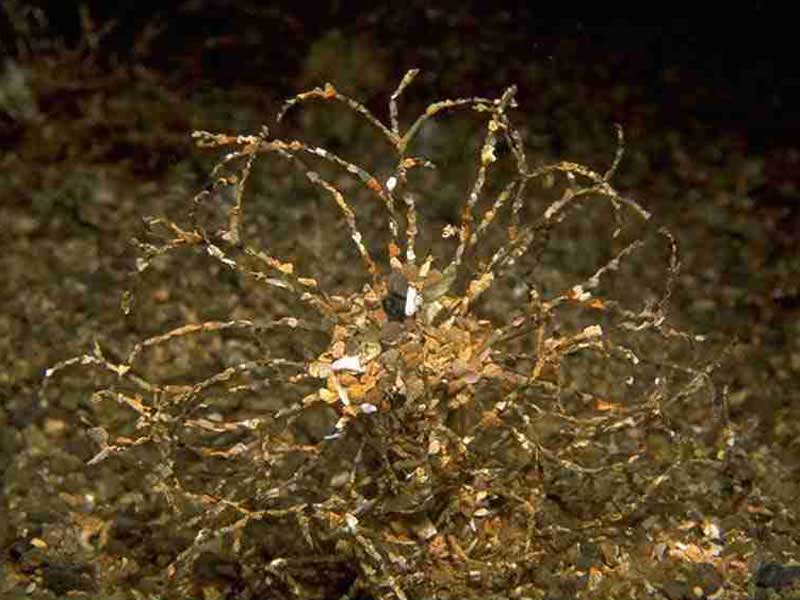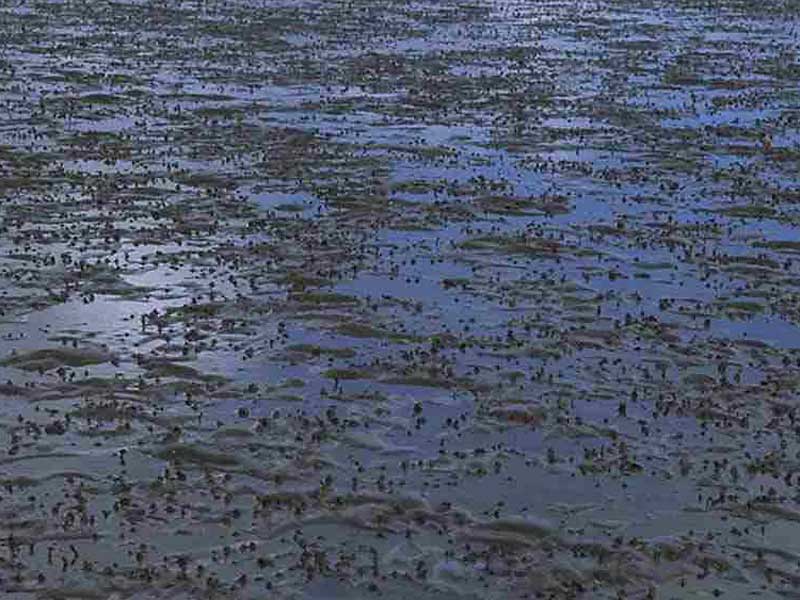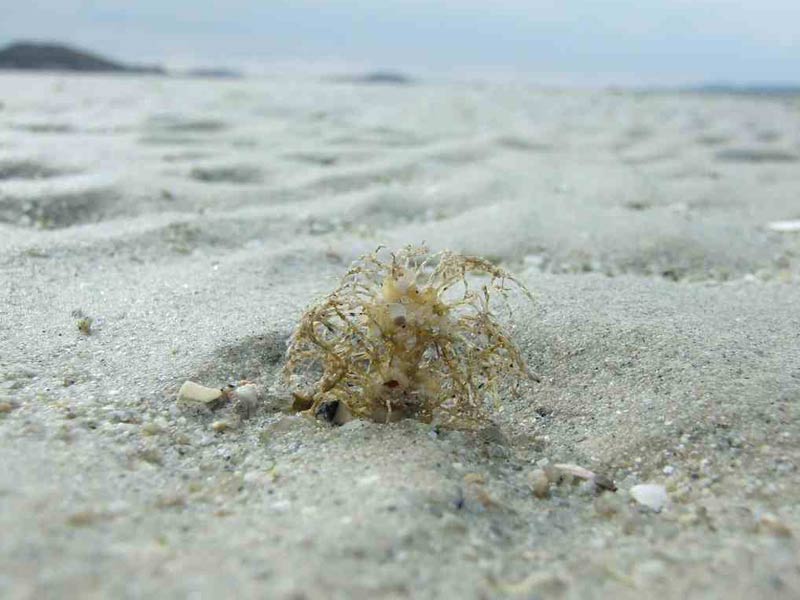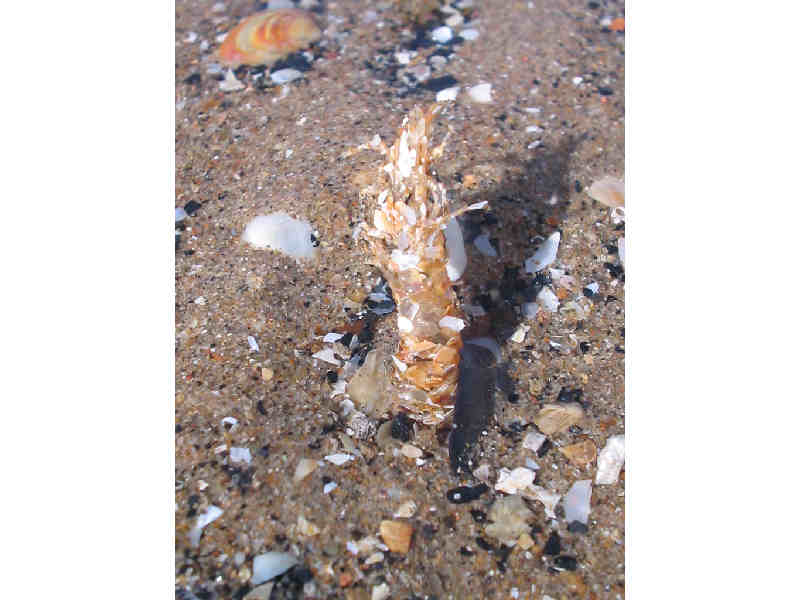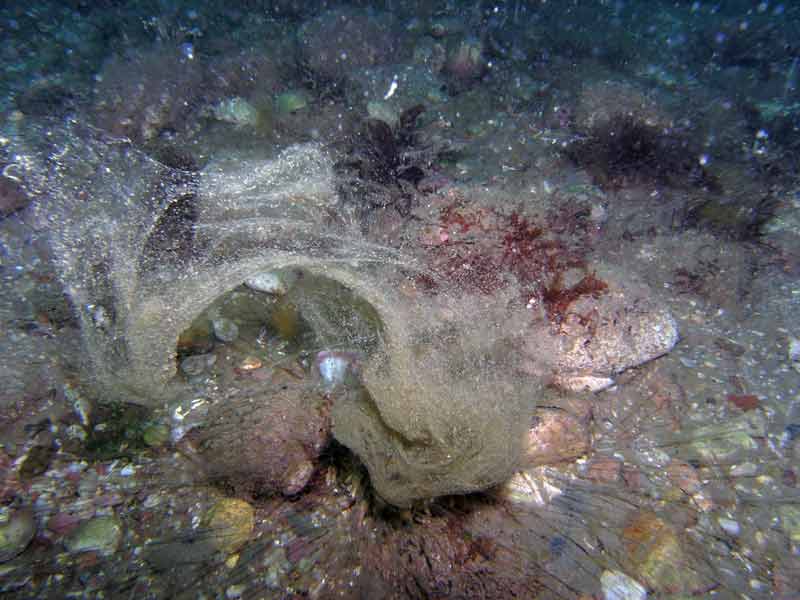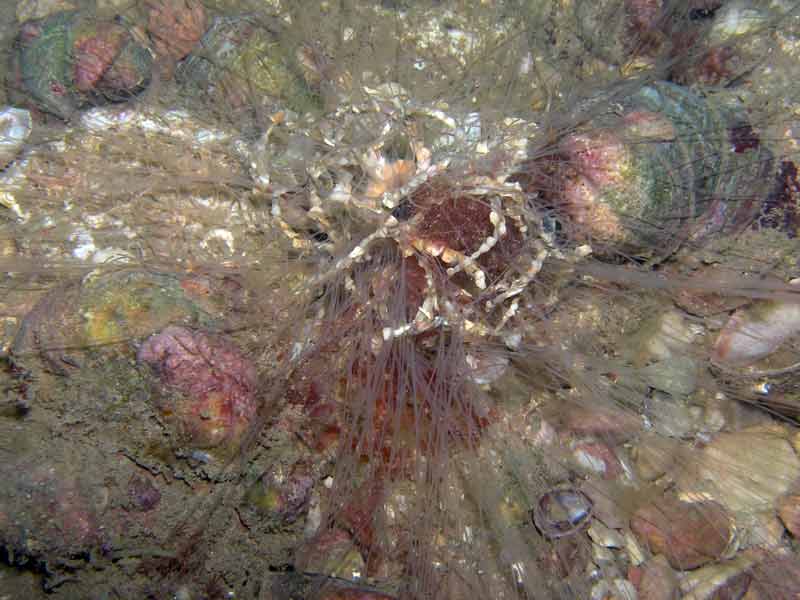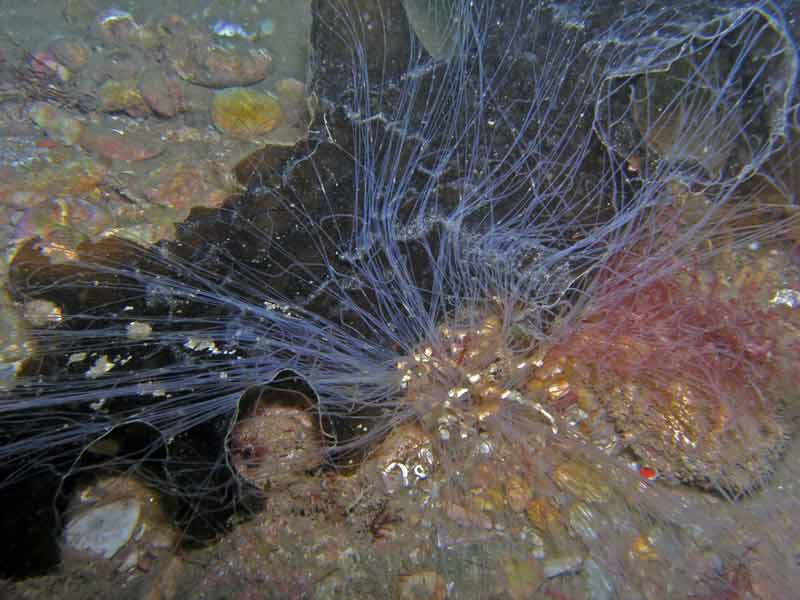Sand mason (Lanice conchilega)
Distribution data supplied by the Ocean Biodiversity Information System (OBIS). To interrogate UK data visit the NBN Atlas.Map Help
| Researched by | Olwen Ager | Refereed by | This information is not refereed |
| Authority | (Pallas, 1766) | ||
| Other common names | - | Synonyms | - |
Summary
Description
Lanice conchilega is a polychaete worm up to 30 cm in length and yellow, pink and brownish in colour. Its body is divided into between 150 and 300 segments, with 17 segments (chaetigers) in the front region. Lanice conchilega has 3 pairs of bushy gills that are blood red in colour. It makes a tube out of sand grains and shell fragments, which has a characteristic frayed end that protrudes above the sand. Lanice conchilega uses its crown of white tentacles to trap particles of food.
Recorded distribution in Britain and Ireland
Lanice conchilega is found around all coasts of Britain and Ireland.Global distribution
Lanice conchilega is found from the Arctic to the Mediterranean, in the Arabian Gulf and the Pacific.Habitat
Lanice conchilega is found in intertidal and subtidal sedimentsDepth range
Intertidal to 1700mIdentifying features
- Up to 30 cm long.
- Body with 150-300 segments.
- 17 segments (chaetigers) in front region.
- 3 pairs of bushy gills.
- Rear parapods as rectangular flaps.
- Yellow, pink or brown in colour.
- Crown of white tentacles.
- Makes tube out of sand grains and shell fragments.
Additional information
No text entered
Listed by
- none -
Biology review
Taxonomy
| Level | Scientific name | Common name |
|---|---|---|
| Phylum | Annelida | Segmented worms e.g. ragworms, tubeworms, fanworms and spoon worms |
| Class | Polychaeta | Bristleworms, e.g. ragworms, scaleworms, paddleworms, fanworms, tubeworms and spoon worms |
| Order | Terebellida | |
| Family | Terebellidae | |
| Genus | Lanice | |
| Authority | (Pallas, 1766) | |
| Recent Synonyms | ||
Biology
| Parameter | Data | ||
|---|---|---|---|
| Typical abundance | Moderate density | ||
| Male size range | 25-30cm | ||
| Male size at maturity | |||
| Female size range | Medium-large(21-50cm) | ||
| Female size at maturity | |||
| Growth form | Tubicolous | ||
| Growth rate | |||
| Body flexibility | High (greater than 45 degrees) | ||
| Mobility | Burrower | ||
| Characteristic feeding method | Active suspension feeder, Surface deposit feeder | ||
| Diet/food source | Detritivore | ||
| Typically feeds on | Detritus | ||
| Sociability | Solitary | ||
| Environmental position | Infaunal | ||
| Dependency | - | ||
| Supports | - | ||
| Is the species harmful? | No information | ||
Biology information
Sociability. Lanice conchilega can be found as a solitary individual or in populations of several thousand per m2.
Feeding. Buhr & Winter (1977) suggested that Lanice conchilega is unlikely to be just a surface deposit feeder as the fringed ends of its tube form an extensive network meaning that detritus will be trapped in the fringe. They suggest that the feeding method is density dependent. At low densities (several dozen individuals per m2) Lanice conchilega will preferentially deposit feed. At high densities (several thousand individuals per m2) competition at the sediment surface will force animals to adopt suspension feeding.
Habitat preferences
| Parameter | Data |
|---|---|
| Physiographic preferences | Open coast, Offshore seabed, Strait or Sound, Estuary, Enclosed coast or Embayment |
| Biological zone preferences | Bathybenthic (Bathyal), Circalittoral offshore, Lower circalittoral, Lower eulittoral, Lower infralittoral, Sublittoral fringe, Upper circalittoral, Upper infralittoral |
| Substratum / habitat preferences | Coarse clean sand, Fine clean sand, Muddy sand, Sandy mud |
| Tidal strength preferences | Moderately strong 1 to 3 knots (0.5-1.5 m/sec.), Strong 3 to 6 knots (1.5-3 m/sec.), Very weak (negligible), Weak < 1 knot (<0.5 m/sec.) |
| Wave exposure preferences | Extremely sheltered, Moderately exposed, Sheltered, Very sheltered |
| Salinity preferences | Full (30-40 psu), Variable (18-40 psu) |
| Depth range | Intertidal to 1700m |
| Other preferences | No text entered |
| Migration Pattern | Non-migratory or resident |
Habitat Information
Hartmann-Shröder (1971; cited in Carey, 1987) reported that Lanice conchilega was found from the low water neap tide mark down to 1700m.Life history
Adult characteristics
| Parameter | Data |
|---|---|
| Reproductive type | Gonochoristic (dioecious) |
| Reproductive frequency | No information |
| Fecundity (number of eggs) | No information |
| Generation time | Insufficient information |
| Age at maturity | Insufficient information |
| Season | April to October |
| Life span | Insufficient information |
Larval characteristics
| Parameter | Data |
|---|---|
| Larval/propagule type | - |
| Larval/juvenile development | Planktotrophic |
| Duration of larval stage | 1-2 months |
| Larval dispersal potential | Greater than 10 km |
| Larval settlement period | Insufficient information |
Life history information
Reproduction. Adult Lanice conchilega were seen to release gametes over several hours in June 1991 (Ansell, 1995). Kuhl (1972) remarked that the larvae of Lanice conchilega occur from April to October. The larvae spend up to 60 days in the plankton so larvae could potentially disperse over a great distance, depending on the hydrographical regime.
Sensitivity review
The MarLIN sensitivity assessment approach used below has been superseded by the MarESA (Marine Evidence-based Sensitivity Assessment) approach (see menu). The MarLIN approach was used for assessments from 1999-2010. The MarESA approach reflects the recent conservation imperatives and terminology and is used for sensitivity assessments from 2014 onwards.
Physical pressures
Use / to open/close text displayed
| Intolerance | Recoverability | Sensitivity | Evidence / Confidence | |
Substratum loss [Show more]Substratum lossBenchmark. All of the substratum occupied by the species or biotope under consideration is removed. A single event is assumed for sensitivity assessment. Once the activity or event has stopped (or between regular events) suitable substratum remains or is deposited. Species or community recovery assumes that the substratum within the habitat preferences of the original species or community is present. Further details EvidenceLanice conchilega lives in the sediment, a loss of substratum would cause a loss of the population. Therefore an intolerance of high has been recorded. A recoverability of high has been recorded (see additional information below). | High | High | Moderate | Low |
Smothering [Show more]SmotheringBenchmark. All of the population of a species or an area of a biotope is smothered by sediment to a depth of 5 cm above the substratum for one month. Impermeable materials, such as concrete, oil, or tar, are likely to have a greater effect. Further details. EvidenceLanice conchilega lives in the sediment and uses sand grains and shell fragments to make a tube that rises several centimetres above the sediment surface. It is therefore, unlikely that silt will smother the worm. It is also likely that Lanice conchilega will be able to move up through the extra sediment, therefore intolerance has been recorded as low. However, smothering by impermeable material is likely to result in anoxic conditions and have a greater impact. | Low | High | Low | Low |
Increase in suspended sediment [Show more]Increase in suspended sedimentBenchmark. An arbitrary short-term, acute change in background suspended sediment concentration e.g., a change of 100 mg/l for one month. The resultant light attenuation effects are addressed under turbidity, and the effects of rapid settling out of suspended sediment are addressed under smothering. Further details EvidenceLanice conchilega is a deposit and/ or suspension feeder and unless the feeding crown is clogged is unlikely to be troubled by an increase in suspended sediment and tolerant has, therefore, been recorded. | Tolerant | Not relevant | Not sensitive | Low |
Decrease in suspended sediment [Show more]Decrease in suspended sedimentBenchmark. An arbitrary short-term, acute change in background suspended sediment concentration e.g., a change of 100 mg/l for one month. The resultant light attenuation effects are addressed under turbidity, and the effects of rapid settling out of suspended sediment are addressed under smothering. Further details EvidenceA decrease in suspended sediment may mean a reduction in the amount of available food for Lanice conchilega, however the protruding part of the tube affects the near bottom flow rate which can lead to an increase in sediment re-suspension (Jones & Jago, 1993) In any case, any adverse affect will lead to a loss of condition rather than mortality. Therefore, an intolerance of low has been recorded. | Low | High | Low | Low |
Desiccation [Show more]Desiccation
EvidenceLanice conchilega is found on the lower shore and is therefore tolerant to some level of desiccation. It can retract into its tube, which can be up to 65cm long, avoiding the effects of desiccation. Only individuals at the upper limit of distribution are likely to be killed, therefore, intolerance has been recorded as intermediate. Desiccation is most likely to be a factor in coarse sands which drains rapidly. | Intermediate | High | Low | Low |
Increase in emergence regime [Show more]Increase in emergence regimeBenchmark. A one hour change in the time covered or not covered by the sea for a period of one year. Further details EvidenceLanice conchilega tubes can be seen on sandflats at low tide. An increase in emergence may lead to an increase in predation by wading sea birds, an increase in exposure to desiccation (see above) and changes in temperature (see below). Intolerance has therefore been recorded as intermediate and a recoverability of high has been recorded (see additional information below). | Intermediate | High | Low | Low |
Decrease in emergence regime [Show more]Decrease in emergence regimeBenchmark. A one hour change in the time covered or not covered by the sea for a period of one year. Further details EvidenceLanice conchilega thrives in the subtidal zone and therefore could potentially benefit from a decreased emergence regime. It is possible that decreased emergence would allow the species to colonize further up the shore. Hence, tolerant* has been recorded. | Tolerant* | Not relevant | Not sensitive* | Low |
Increase in water flow rate [Show more]Increase in water flow rateA change of two categories in water flow rate (view glossary) for 1 year, for example, from moderately strong (1-3 knots) to very weak (negligible). Further details EvidenceIncreased water flow will remove finer sediments or possibly sediments altogether. It may also interfere with feeding. The distribution and extent of the population may be altered due to changes in the preferred substratum of Lanice conchilega. Therefore, an intolerance of intermediate has been recorded. | Intermediate | High | Low | Low |
Decrease in water flow rate [Show more]Decrease in water flow rateA change of two categories in water flow rate (view glossary) for 1 year, for example, from moderately strong (1-3 knots) to very weak (negligible). Further details EvidenceA decrease in water flow will lead to deposition of finer sediments and the possibility of reduced food supply. Changes in water flow rate are likely to change the distribution and extent of the population due to changes in the preferred substratum of Lanice conchilega. Therefore, an intolerance of intermediate has been recorded. | Intermediate | High | Low | Low |
Increase in temperature [Show more]Increase in temperature
For intertidal species or communities, the range of temperatures includes the air temperature regime for that species or community. Further details EvidenceNo information was found regarding tolerance of Lanice conchilega to high temperatures. Lanice conchilega is found over a wide geographical range, in the Arctic, Mediterranean, Arabian Gulf and Pacific. Therefore, it is likely to be tolerant of a wide range of temperatures. An acute increase in temperature may result in physiological stress but is unlikely to lead to mortality. An intolerance of low has therefore been recorded. | Low | High | Low | Low |
Decrease in temperature [Show more]Decrease in temperature
For intertidal species or communities, the range of temperatures includes the air temperature regime for that species or community. Further details EvidenceLanice conchilega is a species that is intolerant of low temperatures (Beukema, 1990). An intertidal population of Lanice conchilega, in the northern Wadden Sea, was wiped out during a severe winter of 1995/96 (Strasser & Pielouth 2001). The population took 3 years to fully recover, as there was low recruitment for the first 2 years. Crisp (1964) found there to be mortality of Lanice conchilega between the tidemarks but not at lower levels. After other hard winters Lanice conchilega recovered fast due to a good larval supply. Intolerance has, therefore, been recorded as high. Recoverability has been recorded as moderate (see additional information below). | High | High | Moderate | High |
Increase in turbidity [Show more]Increase in turbidity
EvidenceLanice conchilega is found in estuarine regions which experience high levels of turbidity. An increase in turbidity would lead to reduced light penetration of the water column. Lanice conchilega is not light dependant, therefore, tolerant has been recorded. | Tolerant | Not relevant | Not sensitive | Not relevant |
Decrease in turbidity [Show more]Decrease in turbidity
EvidenceLanice conchilega is not affected by light availability therefore tolerant has been recorded. | Tolerant | Not relevant | Not sensitive | Not relevant |
Increase in wave exposure [Show more]Increase in wave exposureA change of two ranks on the wave exposure scale (view glossary) e.g., from Exposed to Extremely exposed for a period of one year. Further details EvidenceRees et al. (1977) found that only 1% of the Lanice conchilega population in Colwyn Bay apparently survived after winter storms. An increase in wave exposure is likely to lead to a high mortality of Lanice conchilega, therefore, intolerance has been recorded as high. Recoverability has been recorded as high (see additional information below). | High | High | Moderate | Moderate |
Decrease in wave exposure [Show more]Decrease in wave exposureA change of two ranks on the wave exposure scale (view glossary) e.g., from Exposed to Extremely exposed for a period of one year. Further details EvidenceA decrease in wave exposure in combination with weak tidal streams will invariably lead to a decrease in food supply. If, however the wave exposure is decreased but there are moderate tidal streams it is unlikely Lanice conchilega will be adversely affected. Therefore an intolerance of low has been recorded. | Low | High | Low | Low |
Noise [Show more]Noise
EvidenceNo information was found concerning the intolerance of Lanice conchilega to noise. However, it is unlikely to be affected by noise and vibration at the level of the benchmark | Tolerant | Not relevant | Not sensitive | Low |
Visual presence [Show more]Visual presenceBenchmark. The continuous presence for one month of moving objects not naturally found in the marine environment (e.g., boats, machinery, and humans) within the visual envelope of the species or community under consideration. Further details EvidenceLanice conchilega lives in a tube and its visual range is probably very limited. Not sensitive has therefore been recorded. | Tolerant | Not relevant | Not sensitive | Low |
Abrasion & physical disturbance [Show more]Abrasion & physical disturbanceBenchmark. Force equivalent to a standard scallop dredge landing on or being dragged across the organism. A single event is assumed for assessment. This factor includes mechanical interference, crushing, physical blows against, or rubbing and erosion of the organism or habitat of interest. Where trampling is relevant, the evidence and trampling intensity will be reported in the rationale. Further details. EvidenceLanice conchilega inhabits a permanent tube and is likely to be damaged by any activity that penetrates the sediment. Ferns et al. (2000) investigated the effect of mechanical cockle harvesting (see extraction below). The tubes of Lanice conchilega were damaged but this damage was seen to be repaired. An intolerance of intermediate has therefore been recorded. A recoverability of very high has been recorded (see additional information below). This assessment is for minor abrasion or disturbance, major abrasion, or disturbance would be similar to substratum removal. | Intermediate | Very high | Low | Low |
Displacement [Show more]DisplacementBenchmark. Removal of the organism from the substratum and displacement from its original position onto a suitable substratum. A single event is assumed for assessment. Further details EvidenceDisplacement of Lanice conchilega would lead to increased risk of predation from flat fish (Ansell, 1995). Yonow (1989) observed Lanice conchilega re-establishing tubes immediately after removal from the sediment into a suitable sediment in the laboratory. Intolerance has therefore been recorded as intermediate. | Intermediate | Very high | Low | Low |
Chemical pressures
Use [show more] / [show less] to open/close text displayed
| Intolerance | Recoverability | Sensitivity | Evidence / Confidence | |
Synthetic compound contamination [Show more]Synthetic compound contaminationSensitivity is assessed against the available evidence for the effects of contaminants on the species (or closely related species at low confidence) or community of interest. For example:
The evidence used is stated in the rationale. Where the assessment can be based on a known activity then this is stated. The tolerance to contaminants of species of interest will be included in the rationale when available; together with relevant supporting material. Further details. EvidenceNo information was found directly relating to the effects of synthetic chemicals on Lanice conchilega. However, there is evidence from other polychaete species. Collier & Pinn (1998) investigated the effect on the benthos of Ivermectin, treatment for infestations of sea-lice on farmed salmonids. The ragworm Hediste diversicolor was particularly susceptible, exhibiting 100% mortality within 14 days when exposed to 8 mg/m2 of Ivermectin in a microcosm. Arenicola marina was also intolerant of Ivermectin through the ingestion of contaminated sediment (Thain et al., 1998; cited in Collier & Pinn, 1998) and it was suggested that deposit feeding was an important route for exposure to toxins. Beaumont et al. (1989) investigated the effects of tri-butyl tin (TBT) on benthic organisms. At concentrations of 1-3 g/l there was no significant effect on the abundance of Hediste diversicolor or Cirratulus cirratus after 9 weeks in a microcosm. However, no juvenile polychaetes were retrieved from the substratum and hence there is some evidence that TBT had an effect on the larval and/or juvenile stages of these polychaetes. The high mortality of polychaetes due to exposure to Ivermectin suggests a high intolerance to synthetic chemicals, but with very low confidence in the absence of direct evidence for Lanice conchilega. Recoverability is recorded as high (see additional information below). | High | High | Moderate | Very low |
Heavy metal contamination [Show more]Heavy metal contaminationEvidenceCrompton (1997) suggests the following concentrations of heavy metals would result in the mortality of annelids after short term (4-14 days) exposure:
Bryan (1984) suggests polychaetes are fairly resistant to heavy metals therefore intolerance has been recorded as intermediate. A recoverability of moderate has been recorded (see additional information below). | Intermediate | High | Low | Low |
Hydrocarbon contamination [Show more]Hydrocarbon contaminationEvidenceSoft sediment communities and especially infaunal polychaetes are particularly effected by oil pollution (Suchanek, 1993). A 20 year study investigating community effects after the Amoco Cadiz oil spill of 1978 (Dauvin, 2000) found that a population of Lanice conchilega was established between 1978-84 but disappeared after 1985. An intolerance of intermediate has been recorded. A recoverability of moderate has been recorded (see additional information below) as oil may be retained in sediments preventing re-establishment of populations. | Intermediate | High | Low | Moderate |
Radionuclide contamination [Show more]Radionuclide contaminationEvidenceNo evidence was found regarding the intolerance of Lanice conchilega to radionuclide contamination. | No information | Not relevant | No information | Not relevant |
Changes in nutrient levels [Show more]Changes in nutrient levelsEvidenceModerate nutrient enrichment may be beneficial but increased nutrient enrichment may result in a community dominated with opportunist species (e.g. capitellids). This results in an increase in abundance but a decrease in species richness eventually leading to abiotic, anoxic sediments (Pearson & Rosenberg, 1978). Intolerance has therefore been recorded as intermediate. | Intermediate | Moderate | Moderate | Very low |
Increase in salinity [Show more]Increase in salinity
EvidenceNo information was found concerning the reaction of Lanice conchilega to hypersaline conditions (>40psu). It is unlikely that Lanice conchilega would experience hypersaline conditions and therefore not relevant has been recorded. | Not relevant | Not relevant | Not relevant | Not relevant |
Decrease in salinity [Show more]Decrease in salinity
EvidenceLanice conchilega is found in estuaries but in smaller numbers than fully saline conditions. Intolerance has therefore been recorded as intermediate as a decrease in salinity may lead to a reduction in population numbers. Recoverability has been recorded as high (see additional information below). | Intermediate | High | Low | Low |
Changes in oxygenation [Show more]Changes in oxygenationBenchmark. Exposure to a dissolved oxygen concentration of 2 mg/l for one week. Further details. EvidenceNo information was found on the tolerance of Lanice conchilega to changes in oxygenation. However, Cole et al. (1999) suggest adverse effects on marine species at oxygen concentrations below 4mg/l and probable adverse effects below 2mg/l. Intolerance has therefore been recorded as intermediate. Recoverability has been recorded as high (see additional information below). | Intermediate | High | Low | Low |
Biological pressures
Use [show more] / [show less] to open/close text displayed
| Intolerance | Recoverability | Sensitivity | Evidence / Confidence | |
Introduction of microbial pathogens/parasites [Show more]Introduction of microbial pathogens/parasitesBenchmark. Sensitivity can only be assessed relative to a known, named disease, likely to cause partial loss of a species population or community. Further details. EvidenceNo information was found on diseases of Lanice conchilega. | No information | No information | No information | Not relevant |
Introduction of non-native species [Show more]Introduction of non-native speciesSensitivity assessed against the likely effect of the introduction of alien or non-native species in Britain or Ireland. Further details. EvidenceNo information was found on alien species which may compete with Lanice conchilega. | No information | No information | No information | Not relevant |
Extraction of this species [Show more]Extraction of this speciesBenchmark. Extraction removes 50% of the species or community from the area under consideration. Sensitivity will be assessed as 'intermediate'. The habitat remains intact or recovers rapidly. Any effects of the extraction process on the habitat itself are addressed under other factors, e.g. displacement, abrasion and physical disturbance, and substratum loss. Further details. EvidenceNo information was found that Lanice conchilega is extracted deliberately therefore not relevant has been recorded. | Not relevant | Not relevant | Not relevant | Not relevant |
Extraction of other species [Show more]Extraction of other speciesBenchmark. A species that is a required host or prey for the species under consideration (and assuming that no alternative host exists) or a keystone species in a biotope is removed. Any effects of the extraction process on the habitat itself are addressed under other factors, e.g. displacement, abrasion and physical disturbance, and substratum loss. Further details. EvidenceFerns et al. (2000) investigated the effect of mechanical cockle harvesting on intertidal communities, they found that the harvesting damaged Lanice conchilega as they live in permanent tubes and are therefore incapable of movement, they can however repair damage to tubes. Intolerance has therefore been recorded as intermediate. Recoverability has been recorded as moderate (see additional information below). | Intermediate | Moderate | Moderate | Moderate |
Additional information
Recoverability. Lanice conchilega spends up to 60 days in the plankton and could disperse over a wide area. Heuers & Jaklin (1999) found that areas with adult worms or artificial tubes were settled and areas without these structures were not. Strasser & Pielouth (2001) reported that larvae were seen to settle in areas where there were no adults (see decrease in temperature) but took three years to re-establish the population. Recoverability is, therefore, probably quicker in areas that already have a population of Lanice conchilega but will occur in suitable substratum within only a few years even in the absence of existing populations.
Importance review
Policy/legislation
- no data -
Status
| National (GB) importance | - | Global red list (IUCN) category | - |
Non-native
| Parameter | Data |
|---|---|
| Native | - |
| Origin | - |
| Date Arrived | - |
Importance information
Structure. The tube which Lanice conchilega builds provides structure to the sediment, very much like a hollow rod stabilising the sediment (Jones & Jago, 1993). Lanice conchilega consolidates the sediment, obstructing the activities of predatory burrowers and enabling other sedentary animals to establish themselves (Wood, 1987).
Bibliography
Ansell, A.D., 1995. Surface activity of some benthic invertebrate prey in relation to the foraging activity of juvenile flatfishes. In Proceedings of the 28th European Marine Biology Symposium, Institute of Marine Biology, Crete. 23-28 September 1993. Biology and Ecology of Shallow Coastal Waters (ed. A. Eleftheriou, A.D. Ansell & C.J. Smith), pp. 245-252. Fredensborg: Olsen & Olsen
Beaumont, A.R., Newman, P.B., Mills, D.K., Waldock, M.J., Miller, D. & Waite, M.E., 1989. Sandy-substrate microcosm studies on tributyl tin (TBT) toxicity to marine organisms. Scientia Marina, 53, 737-743.
Beukema, J.J., 1990. Expected effects of changes in winter temperatures on benthic animals living in soft sediments in coastal North Sea areas. In Expected effects of climatic change on marine coastal ecosystems (ed. J.J. Beukema, W.J. Wolff & J.J.W.M. Brouns), pp. 83-92. Dordrecht: Kluwer Academic Publ.
Bryan, G.W., 1984. Pollution due to heavy metals and their compounds. In Marine Ecology: A Comprehensive, Integrated Treatise on Life in the Oceans and Coastal Waters, vol. 5. Ocean Management, part 3, (ed. O. Kinne), pp.1289-1431. New York: John Wiley & Sons.
Buhr, K.J. & Winter, J.E., 1977. Distribution and maintenance of a Lanice conchilega association in the Weser estuary (FRG), with special reference to the suspension-feeding behaviour of Lanice conchilega. In Proceedings of the Eleventh European Symposium of Marine Biology, University College, Galway, 5-11 October 1976. Biology of Benthic Organisms (ed. B.F. Keegan, P.O. Ceidigh & P.J.S. Boaden), pp. 101-113. Oxford: Pergamon Press.
Carey, D.A., 1987. Sedimentological effects and palaeoecological implications of the tube-building polychaete Lanice conchilega Pallas. Sedimentology, 34, 49-66.
Collier, L.M. & Pinn, E.H., 1998. An assessment of the acute impact of the sea lice treatment Ivermectin on a benthic community. Journal of Experimental Marine Biology and Ecology, 230 (1), 131-147. DOI https://doi.org/10.1016/s0022-0981(98)00081-1
Crisp, D.J. (ed.), 1964. The effects of the severe winter of 1962-63 on marine life in Britain. Journal of Animal Ecology, 33, 165-210.
Crompton, T.R., 1997. Toxicants in the aqueous ecosystem. New York: John Wiley & Sons.
Fish, J.D. & Fish, S., 1996. A student's guide to the seashore. Cambridge: Cambridge University Press.
Hayward, P., Nelson-Smith, T. & Shields, C. 1996. Collins pocket guide. Sea shore of Britain and northern Europe. London: HarperCollins.
Hayward, P.J. & Ryland, J.S. (ed.) 1995b. Handbook of the marine fauna of North-West Europe. Oxford: Oxford University Press.
Hayward, P.J. 1994. Animals of sandy shores. Slough, England: The Richmond Publishing Co. Ltd. [Naturalists' Handbook 21.]
Heuers, J. & Jaklin, S., 1999. Initial settlement of Lanice conchilega. Senckenbergiana Maritima, 29 (suppl.), 67-69.
Jones, S.E. & Jago, C.F., 1993. In situ assessment of modification of sediment properties by burrowing invertebrates. Marine Biology, 115, 133-142.
Kuhl, H., 1972. Hydrography and biology of the Elbe Estuary. Oceanography and Marine Biology: an Annual Review, 10, 225-309.
Pearson, T.H. & Rosenberg, R., 1978. Macrobenthic succession in relation to organic enrichment and pollution of the marine environment. Oceanography and Marine Biology: an Annual Review, 16, 229-311.
Rees, E.I.S., Nicholaidou, A. & Laskaridou, P., 1977. The effects of storms on the dynamics of shallow water benthic associations. In Proceedings of the 11th European Symposium on Marine Biology, Galway, Ireland, October 5-11, 1976. Biology of Benthic Organisms, (ed. B.F. Keegan, P. O'Ceidigh & P.J.S. Boaden), pp. 465-474.
Strasser, M. & Pielouth, U., 2001. Recolonization pattern of the polychaete Lanice conchilega on an intertidal sandflat following the severe winter of 1995/96. Helgoland Marine Research, 55, 176-181.
Suchanek, T.H., 1993. Oil impacts on marine invertebrate populations and communities. American Zoologist, 33, 510-523. DOI https://doi.org/10.1093/icb/33.6.510
Wood, E.M., 1987. Subtidal Ecology. London: Edward Arnold.
Yonow, N., 1989. Feeding observations on Acteon tornatilis (Linnaeus) (Opisthobranchia: Acteonidae). Journal of Molluscan Studies, 55, 97-102.
Datasets
Bristol Regional Environmental Records Centre, 2017. BRERC species records recorded over 15 years ago. Occurrence dataset: https://doi.org/10.15468/h1ln5p accessed via GBIF.org on 2018-09-25.
Centre for Environmental Data and Recording, 2018. Ulster Museum Marine Surveys of Northern Ireland Coastal Waters. Occurrence dataset https://www.nmni.com/CEDaR/CEDaR-Centre-for-Environmental-Data-and-Recording.aspx accessed via NBNAtlas.org on 2018-09-25.
Cofnod – North Wales Environmental Information Service, 2018. Miscellaneous records held on the Cofnod database. Occurrence dataset: https://doi.org/10.15468/hcgqsi accessed via GBIF.org on 2018-09-25.
Environmental Records Information Centre North East, 2018. ERIC NE Combined dataset to 2017. Occurrence dataset: http://www.ericnortheast.org.ukl accessed via NBNAtlas.org on 2018-09-38
Fenwick, 2018. Aphotomarine. Occurrence dataset http://www.aphotomarine.com/index.html Accessed via NBNAtlas.org on 2018-10-01
Fife Nature Records Centre, 2018. St Andrews BioBlitz 2014. Occurrence dataset: https://doi.org/10.15468/erweal accessed via GBIF.org on 2018-09-27.
Fife Nature Records Centre, 2018. St Andrews BioBlitz 2015. Occurrence dataset: https://doi.org/10.15468/xtrbvy accessed via GBIF.org on 2018-09-27.
Fife Nature Records Centre, 2018. St Andrews BioBlitz 2016. Occurrence dataset: https://doi.org/10.15468/146yiz accessed via GBIF.org on 2018-09-27.
Kent Wildlife Trust, 2018. Biological survey of the intertidal chalk reefs between Folkestone Warren and Kingsdown, Kent 2009-2011. Occurrence dataset: https://www.kentwildlifetrust.org.uk/ accessed via NBNAtlas.org on 2018-10-01.
Kent Wildlife Trust, 2018. Kent Wildlife Trust Shoresearch Intertidal Survey 2004 onwards. Occurrence dataset: https://www.kentwildlifetrust.org.uk/ accessed via NBNAtlas.org on 2018-10-01.
Lancashire Environment Record Network, 2018. LERN Records. Occurrence dataset: https://doi.org/10.15468/esxc9a accessed via GBIF.org on 2018-10-01.
Manx Biological Recording Partnership, 2017. Isle of Man wildlife records from 01/01/2000 to 13/02/2017. Occurrence dataset: https://doi.org/10.15468/mopwow accessed via GBIF.org on 2018-10-01.
Manx Biological Recording Partnership, 2018. Isle of Man historical wildlife records 1995 to 1999. Occurrence dataset: https://doi.org/10.15468/lo2tge accessed via GBIF.org on 2018-10-01.
Manx Biological Recording Partnership, 2022. Isle of Man historical wildlife records 1990 to 1994. Occurrence dataset:https://doi.org/10.15468/aru16v accessed via GBIF.org on 2024-09-27.
Merseyside BioBank., 2018. Merseyside BioBank (unverified). Occurrence dataset: https://doi.org/10.15468/iou2ld accessed via GBIF.org on 2018-10-01.
Merseyside BioBank., 2018. Merseyside BioBank Active Naturalists (unverified). Occurrence dataset: https://doi.org/10.15468/smzyqf accessed via GBIF.org on 2018-10-01.
National Trust, 2017. National Trust Species Records. Occurrence dataset: https://doi.org/10.15468/opc6g1 accessed via GBIF.org on 2018-10-01.
NBN (National Biodiversity Network) Atlas. Available from: https://www.nbnatlas.org.
Norfolk Biodiversity Information Service, 2017. NBIS Records to December 2016. Occurrence dataset: https://doi.org/10.15468/jca5lo accessed via GBIF.org on 2018-10-01.
North East Scotland Biological Records Centre, 2017. NE Scotland other invertebrate records 1800-2010. Occurrence dataset: https://doi.org/10.15468/ifjfxz accessed via GBIF.org on 2018-10-01.
OBIS (Ocean Biodiversity Information System), 2025. Global map of species distribution using gridded data. Available from: Ocean Biogeographic Information System. www.iobis.org. Accessed: 2025-08-05
South East Wales Biodiversity Records Centre, 2018. SEWBReC Worms (South East Wales). Occurrence dataset: https://doi.org/10.15468/5vh0w8 accessed via GBIF.org on 2018-10-02.
South East Wales Biodiversity Records Centre, 2018. Dr Mary Gillham Archive Project. Occurance dataset: http://www.sewbrec.org.uk/ accessed via NBNAtlas.org on 2018-10-02
Yorkshire Wildlife Trust, 2018. Yorkshire Wildlife Trust Shoresearch. Occurrence dataset: https://doi.org/10.15468/1nw3ch accessed via GBIF.org on 2018-10-02.
Citation
This review can be cited as:
Last Updated: 08/05/2008

